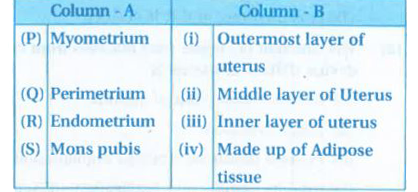Match the proper pairs :
[A][B](P)SN2(i)Freon(Q)TNP(ii)Hetrolytic fission(R)CFC(iii)No Hetrolytic fission(S)SN1(iv)Picric acid(v)Fire extinguisher Solution in Gujrati
(P - ii), (Q - iv), (R - i), (S - iii)
(P - iv), (Q - ii), (R - iii), (S - v)
(P - ii), (Q - i), (R - iv), (S - v)
(P - iii), (Q-iv), (R -i), (S - ii)
The correct Answer is:D
[A][B](P)SN2(iii)No Heterolytic fission(Q)TNP(iv)Picric acid(R)CFC(i)Fron(S)SN1(ii)Heterolytic fission
Topper's Solved these Questions
- HALOALKANES AND HALOARENESBOOK - KUMAR PRAKASHANCHAPTER - HALOALKANES AND HALOARENESEXERCISE - SECTION - D NCERT EXEMPLAR SOLUTION (Long Answer Type Questions)
3 Videos
- GENERAL PRINCIPLES AND PROCESSES OF ISOLATION OF ELEMENTSBOOK - KUMAR PRAKASHANCHAPTER - GENERAL PRINCIPLES AND PROCESSES OF ISOLATION OF ELEMENTSEXERCISE - SECTION - E (MCQs ASKED IN GUJET/BOARD EXAMS)
46 Videos
- POLYMERSBOOK - KUMAR PRAKASHANCHAPTER - POLYMERSEXERCISE - SECTION - E (MCQs asked in Board Exams)
51 Videos
Similar Questions
Some alkyl halides undergo substitution whereas some undergo elimination reaction on treatment with bases. Discuss the structural features of alkyl halides with the help of examples which are responsible for this difference.
View SolutionDuring electrolysis of aqueous solution of Na2SO4 using graphite electrode .........
View SolutionWhich polymer is used in preparation of capsules ?
View SolutionGiven, sn=1+q+q2+.....+qn,Sn=1+q+12+(q+12)2+...+(q+12)n,q≠1 prove that n+1C1+n+1C2s1+n+1C3s2+......+n+1Cn+1sn=2nSn.
View SolutionRate of SN1 & SN2 reactions for the isomers of C4H9Br is
i. n- Butylbromide
ii isobutylborimide
ii s-Butylbromide
iv. t-Butylbromide
a. i>ii>iii>iv for SN2
b. i>ii>iii>iv for SN1
c. iv>iii>ii> for SN2
d. iv>iii>ii>i for SN1
View Solutionकिसी गुणोत्तर श्रेणी प्रथम पद a तथा सार्वअनुपात r है तथा Sn, इसके n पदों का योग है, तो सिध्द कीजिए कि-
(i) S1+S2+...+Sn=na1−r−ar(1−rn)(1−r)2
(ii) S1+S3+S5+...+S2n−1=an1−r−ar(1−r2n)(1−r)2.(1+r)
View SolutionIf S1=n∑r=1r,S2=n∑r=1r2,S3=n∑r=1r3 then : limn→∞S1(1+S88)(S2)2 =
View SolutionHave given S_(n)=1+q+q^(2)+.....+q^(n) , S_(n)=1 +(q+1)/(2)+((q+1)/(2))^(2)+....+((q+1)/(2))^(n), q ne 1 Then prove that ""^(n+1)C_(1)+""^(n+1)C_(2)S_(1)+""^(n+1)C_(3)S_(2)+.....+""^(n+1)C_(n+1) S_(n)=2^(n)S_(n)
View SolutionExplain the hetrolytic fission of a covalent bond?
View SolutionIf Sn=n⋅(2n2+9n+13)6 ( Sn = sum of first n terms of the sequence) then the value of ∑∞i=11r√(Sr−Sr−1)
View Solutionsum_(r=1)^(n) sum_(s=1)^(n)S_(rs)2^(r)3^(s) Where S_(rs) = 0 , If r ne s And S_(rs) = 1 , If r = s, is the sum of
View SolutionSN1 reaction undergoes in which type of fission ?
View SolutionThe Hetrolytic fission will be favoured by polar nature of the bond, polar solvents, presence of ions due to acid and base catalyst
View SolutionMatch Column A with Column B

(A) (P-i), (Q-ii), (R-iv), (S-iii)
(B) (P-ii), (Q-i), (R-iii), (S-iv)
(C) (P-ii), (Q-iii), (R-iv), (S-i)
(D) (P-iv), (Q-iii), (R-ii), (S-i)
View SolutionMatch the following (A) (i-P), (ii-S), (iii-R), (iv-Q) (B) (i-Q), (ii-S), (iii-P), (iv-R) (C) (i-Q), (ii-P), (iii-R), (iv-S) (D) (i-P), (ii-R), (iii-Q), (iv-S)
View Solution